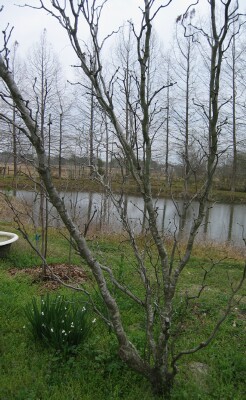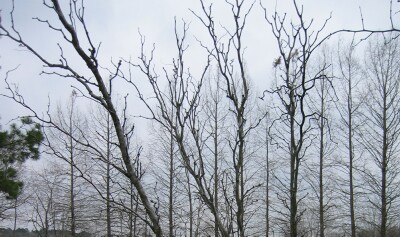
Home:
Grafting Tips:
TAMU Grafting:
Fruit Trees:
Citrus Trees:
Around the
yard:
Useful stuff:
Our Edible Landscaping:
Talbert Farms:
18,000 visitors since the beginning
Visitors since 20Feb05
Sam and Ginger's Edible Landscape zone 9a
Santa Fe, TX
Page 1 of 3 ( to Page 2
Sign/Read The Our Edible Landscaping Guestbook
To start with, I do not consider our edible landscape an orchard. It is my idea of landscaping that some people might consider to having gotten out of hand. When I started, a plant had to meet two criteria, it had to be edible, and practically maintenance free. If a plant can’t survive on its own it could die and I would try something else. The soil is heavy black (gumbo) that is usually too wet or too dry to work. When it is wet it sticks to your feet like molasses, and when it is dry it is like a rock. The only plants here that are not planted in gumbo are the roses, in raised beds, the blueberries in raised bed, and the grapes in fill sand. Most of the trees are planted in a small hole just large enough to spread the roots. The hole was back filled with the same dirt that came out of the hole. After I dig the hole with a shovel, I use a spading fork to dig or tear out another inch completely around the hole. This breaks the glaze caused by the shovel when the ground is moist or wet. If the glaze is allowed to remain it will dry and harden. The result is you have planted your tree in the ground in a "ceramic pot" where it cannot drain, and the roots cannot penetrate the wall of the glaze. If the tree or shurb is potted I remove most, if not all of the dirt in the pot from the roots of the plan before placing the plant in the hole. I use the potting soil from the pot as mulch on top of the ground around the plant. I have persimmon trees next the road that were planted in a "ceramic pot" with the dirt attached 10 years ago and they are just now starting to grow. Two or three are six feet tall, the others are not quite so large. The large persimmon trees along the drive are a year older and were planted bare-rooted.
Feijoas(Pineapple Guava)
Pineapple guava is probably the easiest and most carefree fruit and ornamental tree that you can grow. It's a large evergreen shrub that can be trained into a tree. It has beautiful edible flowers in the spring and fruit similar to a kiwi in the fall. The petals of the flower are edible fresh, in a salad, or other dishes. The fruit is ripe when it falls from the tree. You don't even have to make a decision as to when to pick the fruit. The named varieties cost upwards of $35, but the ornamental ones in nurseries for $10 are almost as large and tasty. The downside to feijoas is that it will freeze to the ground at about 10 degrees Fahrenheit. Our tree froze to the ground in 1989 but three years later it was six feet in diameter, and full of fruit.
Gumi( Elaeagnus multiflora)
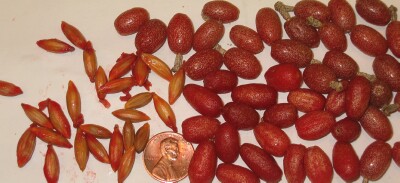 |
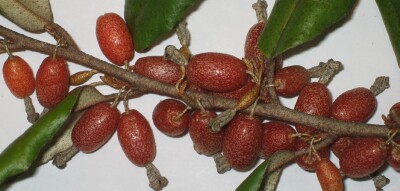 |
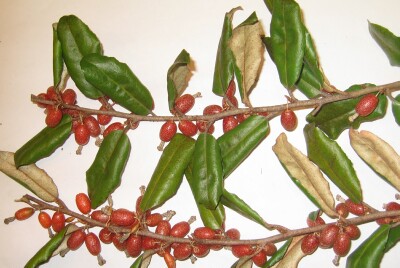 |
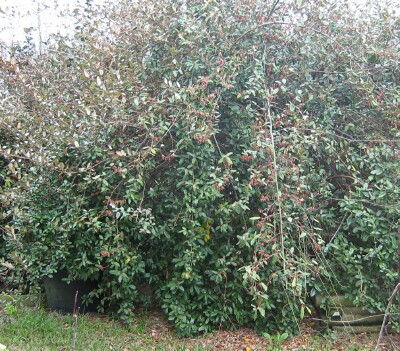 |
Elaeagnus is a large dense evergreen shrub. The top of the leaves are shiny green with the underneath side being silver with gold flecks. These shrubs bloom in the fall with tiny inconspicuous flowers that smell like cinnamon, but you can smell the tree 30 feet away. In the spring the tree has bright red, gold flaked, fruit about the size of jelly beans. I made a batch of wine from the fruit one year. We were tasting it to see how much sugar to add to make a sweet wine. I took a very tiny sip and felt my toes tingle. This was a new experience for me. I came in the house and started checking to see what I had done to cause such a sensation. After going over my notes and doing some calculations I realized that I had made 40 proof wine. I added too much sugar and the yeast had converted it all into alcohol. Most yeast stops fermenting at about 34 to 36 proof - but not this time.
Jujube (Chinese date)
So jujube in winter time
|
|
|
This would have to be my personal favorite. The first year the tree is planted, if it is very dry, the tree may need an occasional watering. After the first year the tree will survive on five inches of rain a year, it will grow faster if it is watered occasionally during dry spells. Most varieties start producing some fruit within three years of being transplanted. We have about 30 varieties and about 20 of those have produced fruit. We have not had any disease, fungus, insect, bird, or critter problem. There is a wide variation in taste, production, and looks of the different varieties.
The two oldest trees are Lang and Sherwood. They are about 25 years old. I weighed the fruit from the Lang for five consecutive years. The lowest production was 100 pounds and up to 140 pounds. During the same time period the Sherwood had fruit for three years, about 20 pounds was the top production, and two years it didn’t have any fruit. The fruit should be harvested early in the morning before the dew has had time to dry. The fruit is crisp if harvested early in the morning, but if you wait until the afternoon the fruit becomes pithy and tasteless. The next morning the fruit will become crisp again. The texture of the fruit is improved with an occasional watering of the tree during a long dry spell. The easiest way to harvest the fruit is to spread a sheet or tarpaulin on the ground and shake the limbs. I have taken most of the varieties to a taste tasting at Bear Creek Park for the last three or four years and the varieties A&M recommends are way down at the bottom of the list.
The downside to the Jujube’s are that they are very thorny. In some varieties thorns seemed to decrease as the tree ages. Most of the rootstock send up numerous suckers so you could have a thorny thicket in a couple of years if you let them go. The fruit does not keep well after harvesting, about three weeks in the refrigerator is the maximum that I have been able to keep the fruit edible. The bette tasting varieties are hard to find and expensive to buy. The couple of upside points to be considered is that they sucker a lot. Meyer in California digs up the suckers, tapes a graft on the top and sells them for $30 a tree for the two foot high ones plus shipping and handling. This was the price four years ago. I bought graft wood from him for 2 dollars a stick and did my own grafting. The trees can also be considered ornamental for landscaping, especially the So. The branches are twisted and gnarled and it is especially showy when it loses its leaves.
A thumbnail sketch of some of the Jujube varieties we are growing:
1. So – Ping-pong ball size fruit, excellent flavor, sweet, dark red-brown, attractive tree even without leaves.
2. Sugar Cane – Ping-pong ball size fruit, sweet flavor, dark red-brown color when ripe, thorny tree.
3. Sherwood – Large thumb size fruit, barrel shaped, good flavor, erect growing tree, poor production.
4. Lang – Largest of the fruit, will spoil before it turns the desired dark color in the Gulf Coast climate, so picked slightly green. Makes excellent dried fruit, Jujube butter, and will substitute for apples in a pie; extremely productive.
5. Silver Hill – Same quality and properties as Lang above, may be the same tree.
6. Tiger Tooth – Fruit shaped like a large canine tooth, good fruit, ripens late.
7. Tsao – (the Oriental word for jujube) 1½ inches long and ½ inch diameter, good flavor ripens to dark color, moderate production.
8. Sweet Meaty – Extremely vigorous, thorny, productive, large marble size, sweet tart fruit, similar to if not the same fruit grown in India.
9. Ga-866 – Supposed to be very sweet 43 percent sucrose, didn’t seem that sweet to me, two trees have produced a dozen or so fruit in six years.
10. GI 7-62 – Shaped like small flattened pumpkin, 1½ inches in diameter and one inch high, excellent flavor, sweet, juicy, crisp, and very productive, one of the favorites at the taste tasting.
11. GI 1183 – Barrel shaped, moderately productive, mediocre taste.
12. Shu Min – Barrel shaped fruit a little larger than Sherwood, has slight pear flavor, fair production.
13. Li – 1½ inches long and one inch diameter, too young to evaluate, taste seems to be above average.
14. Yu – Eight year-old graft; no fruit.
15. Ant Admire – First fruit last year, good taste, and not enough fruit or time to evaluate properly.
16. Si Hong – Same as No. 15
17. Sept. Late – Same as No. 15
18. Globe – Same as No. 15
19. Honey Jar
20. Burmese, Salay Zee-Thee – Evergreen seedling, blooms in the fall, sets fruit in the winter and will lose fruit due to frost.I have six Russian varieties that have not fruited yet. They are not growing out very fast. It will probably be several years before they do produce fruit.
Papaya
Papaya are fast-growing herbaceous plants are male, female, or bisexual. The smaller papaya, that are found in the produce section of the grocery store, are from Hawaii and fall in the bixsexual category. The large size fruit, small watermelon size, come from South America, and are male and female plants. The heterosexual plants have been known to change sexes when there was no opposite sex available. The female and perfect flowers are attached to the main trunk; the male flowers are on the stems three to six inches long. The orange meated Hawaii fruit generally make a shorter plant, and will produce fruit in one year. The yellow meated variety grows too tall and takes too long to produce fruit on the Gulf Coast.
It is hard to produce fruit on the South American varieties for the same reason. If you want to try the South American varieties, plant five or six plants close together and cut down all the males except one when they start to bloom. To try growing your own papaya, when you find one in the store that you like, remove and wash the seeds, let them dry for a day or two. Store them in a small bottle or zip-lock bag. Plant four or five seeds in a 5 or 10 gal. pot in November or December. Keep the pot in the garage or greenhouse. After the likelihood of a frost has passed, they can be planted in the yard; preferable on the south side of a building. Keep the ground moist and well mulched. You should have fruit ripening by late summer or early fall. When a hard frost defoliates the plant pick the fruit, peel and cut it up, and cook it like squash.
The trunk of the papaya is similar to bamboo in that it is hollow with membranes filling the hollow tube every 8 to 10 inches. It takes a hard freeze (25 degrees F.) or lower to kill a mature plant, but a hard frost will kill the top. If left alone, the plant will die from the top down. You can saw the plant off below the dead trunk and cover the top with plastic, secure the plastic with tape to keep water from entering the hollow trunk. The plant will produce new trunks below where it was cut off. With the massive root system already established, the plant will produce more fruit, and earlier, than it did the previous year. One downside of growing papayas is when the plant dies you need to dig out the major roots as soon as possible. Digging out the roots after a couple of months, to plant something else in its place, produces a major unpleasant odor. Occasionally, we have a late or prolonged spring, with cool nights. The plant will not start growing soon enough to ripen the fruit before late fall of that year. In my opinion, if you buy papaya at the store because you like the taste, you should try to grow your own. There is no comparison between fruit that has been in cold storage, and fruit that was allowed to ripen at room temperature, then chilled before eating.
Blueberries
Rabbiteye blueberries can be grown in this area with very little effort, after the original expense and labor. You will need two or three low chill varieties for cross pollination and bird netting to keep the birds from getting the fruit when it starts to ripen. A raised bed 10 inches high should be built in a sunny location that doesn’t have standing water. Another option would be grown them in large (at least 35 gal. or larger) pots. I planted my bushes in pure Canadian sphagnum peat moss, but it would probably work better to use 10 percent sharp sand and 10 percent compost by volume (Wear a dust mask while mixing.) Blueberries need a ph of 4.5 to 5.2. You can maintain this low-level ph by adding soil sulfur to the planting medium. The plants need at least five gallons of water a week, and it might be advisable to install a simple automatic watering system.
It is advisable to prepare your bed six months to a year before you plant the bushes. This gives the sphagnum time to settle and you can adjust the ph before planting time. I didn’t start out so much to grow blueberries as to check out Dr. Bob Randall’s statement that you could grow blueberries in Houston and they would survive without having to be watered twice a week. I did everything wrong but four of the six original plants have survived for five years. I started the bed in the spring of the year by digging down into the clay levy around the stock pond for one side of the bed. I used hollow tile for other three sides. I spread out four sacks of four cubic feet of sphagnum peat moss. I installed a drip system, that I later found out didn’t work; then I added four more sacks of sphagnum peat moss.
By this time, it was the middle of the summer when I started looking for my blueberry plants. They were on sale for a dollar a plant. I put six plants in an area that should have had three at the most. The last two years have ben among the driest in recorded history. They were watered maybe once a month and have received no fertilizer since I planted them over the last two years. I purchased a 55 gal. plastic drum so I could add acid to lower the ph of the irrigation water but I haven’t hooked it up. The four surviving blueberries are Brightwell, T. Tif Blue, Woodard, and Bluebell. Dr. Randall was correct.
Bananas
Bananas are another easy to grow crop that take very little care except for wind and freeze protection. Nearly all the plants you see in this area are 12 to 15 feet tall and most of the fruit that I have tasted isn’t particularly good. There are dwarf varieties that only grow 5 to eight feet and have superior tasting fruit. We have a Dwarf Cavendish banana that you can not tell the difference between it and a store bought banana. The Dwarf Cavendish only grow eight feet tall. A superb dwarf variety is available that only grows to two feet tall. We have two more varieties that haven’t fruited. The plant will start to bloom when it has grown 43 leaves.
When the plant starts to bloom, it will leave little bananas on the stalk as it grows. When the bananas stop forming for a couple inches, cut off the bloom to conserve the plants energy for the fruit. You may have to tie or brace the stalk of bananas to keep from putting too much weight on the trunk. After all the bananas have been harvested, cut the main trunk off close to the ground to conserve the energy in the roots for the pups (suckers) for next year’s crop of bananas. Some of the suckers can be cut from the mother plant with a sharp spade, dug up and moved to another location or given away. The plant will benefit from periodic watering and ammonium sulfate (21-0-0). Apply ¼ cup a month after the young plant starts to grow and increase to 2 cups per month when the plant starts fruiting. My plants don’t receive anything close to this type treatment.
Loquat
The loquat is a small evergreen tree that has large fuzzy leaves. It blooms in the fall, grows the fruit in the winter, and ripens the fruit in the spring. There are named varieties that can be ordered for a price. You can plant a seed and in three to five years it should start fruiting. There is a wide variation in flavor and sweetness of the fruit; some of the fruit is yellow meated and some are white meated. There is also several months variation in ripening dates between trees. This is the second week in April and this year we have been eating fruit for two months while one tree is just now starting to ripen its fruit. We tasted fruit from a number of different trees and saved the seeds of the ones we liked and planted them.
I also planted a couple seeds from a less desirable tasting fruit to use for root stock to graft on a better tasting variety. I didn’t do any grafting but you can definitely tell the difference in the taste of the fruit from different trees. The downside to raising loquat is that a light freeze, when the tree is in bloom, will wipe out your crop for the year. After the fruit has set and attained a little size, the fruit can withstand 25 degrees Fahrenheit for a short while without damage. The tree itself can withstand 10 to 15 degrees Fahrenheit. The trees’ susceptibility to fire blight is the major problem I have encountered with loquat. I have cut out some major branches on small trees and it did not seem to bother the tree as to production or vigor.
EdiblePg1.htm

